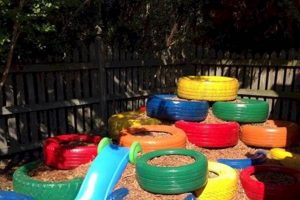The concept involves crafting activity boards using readily available materials to stimulate sensory exploration and the development of fine motor skills in young children. These boards typically incorporate items such as latches, zippers, buttons, switches, and wheels, providing a safe and engaging environment for tactile learning and discovery.
Such constructed play surfaces offer numerous advantages, including fostering independence, promoting problem-solving abilities, and enhancing hand-eye coordination. Historically, educators and parents have recognized the value of hands-on learning, and these boards represent a contemporary application of that principle, offering a cost-effective and customizable learning resource.
The following sections will delve into various design considerations, material selection, and construction techniques for creating effective and engaging activity centers for children. Discussions will include age-appropriateness, safety precautions, and innovative approaches to maximize the developmental benefits of the finished product.
Construction Guidance
The following guidelines are provided to assist in the effective and safe assembly of tactile learning centers. Careful consideration of these points will enhance the developmental value and longevity of the finished product.
Tip 1: Prioritize Safety: All components must be securely fastened to the board to prevent detachment and potential choking hazards. Select non-toxic materials and finishes to ensure the child’s well-being.
Tip 2: Age-Appropriate Selection: Adapt the complexity of the activities to the child’s developmental stage. Simpler mechanisms, such as large buttons and basic latches, are suitable for younger children, while older children may benefit from more intricate puzzles and fasteners.
Tip 3: Variety of Textures and Materials: Incorporate a range of textures, such as smooth wood, rough fabrics, and metallic surfaces, to stimulate sensory exploration. Different materials offer diverse tactile experiences, enriching the learning process.
Tip 4: Durable Base Material: Choose a sturdy and stable base material, such as plywood or a solid wood board, to withstand repeated use and prevent warping or breakage. Adequate thickness is crucial for ensuring structural integrity.
Tip 5: Secure Fastening Techniques: Utilize appropriate fastening methods, such as screws, bolts, and industrial-strength adhesives, to ensure that all components are firmly attached. Avoid using nails or staples, as they may pose a safety risk.
Tip 6: Regular Inspection and Maintenance: Routinely inspect the board for loose components, sharp edges, or signs of wear and tear. Promptly repair or replace any damaged items to maintain safety and functionality.
Tip 7: Consider Thematic Integration: Incorporate thematic elements, such as colors, shapes, or animal motifs, to enhance engagement and stimulate imaginative play. A cohesive theme can create a more visually appealing and stimulating learning environment.
Adherence to these guidelines ensures that the finished product will serve as a valuable and safe educational resource, promoting cognitive development and fine motor skill enhancement in young children. The subsequent section will offer concluding remarks regarding the creation and application of these interactive learning tools.
1. Sensory Stimulation
Sensory stimulation, a critical aspect of early childhood development, finds practical application through carefully designed and constructed activity centers. These interactive surfaces offer a controlled environment for young children to explore various tactile, auditory, and visual stimuli, directly contributing to cognitive and motor skill development.
- Tactile Exploration
The inclusion of diverse texturessmooth wood, rough fabrics, corrugated surfacesprovides a range of tactile experiences. This exploration aids in the development of tactile discrimination skills, enabling children to differentiate between materials and understand their properties. For instance, contrasting a soft felt square with a textured metal knob allows a child to experience different tactile sensations within a single activity.
- Auditory Input
Incorporating elements that produce sound, such as bells, rattles, or clicking mechanisms, offers auditory stimulation. These sounds can enhance engagement and contribute to the development of auditory processing skills. The gentle chime of a small bell, for example, provides auditory feedback that reinforces the child’s actions and promotes cause-and-effect understanding.
- Visual Engagement
Vibrant colors, contrasting patterns, and moving parts contribute to visual stimulation. These visual elements capture attention and encourage visual tracking and focus. Utilizing primary colors and incorporating shapes that rotate or slide enhances visual engagement and supports the development of visual perception skills.
- Kinesthetic Awareness
Manipulation of various objects, such as turning knobs, sliding bolts, and opening latches, promotes kinesthetic awareness. These actions provide feedback about body position and movement, fostering coordination and motor planning skills. Engaging with these elements requires the child to use their hands and fingers in a coordinated manner, thereby refining their fine motor abilities.
The strategic integration of these sensory elements, within a safe and structured environment, underscores the value of well-designed activity centers. These creations provide a focused platform for early sensory learning and developmental progress.
2. Fine motor skills
The development of fine motor skills is a crucial aspect of early childhood development, and activity centers represent a practical means of facilitating this growth. These skills, involving the coordination of small muscles in the hands and fingers, are essential for tasks such as writing, buttoning clothes, and manipulating objects.
- Pincer Grasp Development
The pincer grasp, the ability to hold small objects between the thumb and forefinger, is fundamental for many fine motor tasks. Activity centers often include small knobs, pegs, or beads that encourage the development of this grasp. Manipulating these objects strengthens the muscles in the fingers and improves hand-eye coordination, skills necessary for writing and other precision tasks.
- Bilateral Coordination
Many activities on these boards require the use of both hands working together. For example, a child may need to hold a latch with one hand while opening it with the other. This type of activity promotes bilateral coordination, the ability to use both sides of the body in a coordinat
ed manner, which is essential for tasks such as cutting with scissors or tying shoelaces. - Hand-Eye Coordination
The integration of visual information with hand movements is critical for fine motor control. Activities such as inserting pegs into holes or fitting shapes into corresponding slots require the child to visually track their hand movements and adjust their grip accordingly. This process strengthens hand-eye coordination and improves the child’s ability to perform precise movements.
- Dexterity and Manipulation
These learning tools often feature a variety of fasteners, such as buttons, zippers, and snaps, that require the child to use their fingers in a coordinated manner. Working with these fasteners improves dexterity, the ability to perform skillful and precise movements with the hands. This dexterity is essential for tasks such as writing, drawing, and using utensils.
The development of fine motor skills through interaction with such centers lays a solid foundation for future academic and practical endeavors. By providing opportunities for children to practice and refine these skills, these handmade resources contribute significantly to their overall development and independence.
3. Cognitive development
Cognitive development, encompassing the processes of thought, reasoning, and problem-solving, is significantly influenced by early sensory experiences. Appropriately designed interactive play surfaces serve as instrumental tools for fostering these cognitive abilities in young children.
- Cause and Effect Reasoning
Interactive play centers often incorporate elements that respond directly to a child’s actions, such as switches that activate lights or buttons that trigger sounds. These features enable children to observe the direct consequences of their actions, fostering an understanding of cause and effect relationships. For example, when a child presses a button and a light illuminates, they learn that their action caused a specific outcome. This foundational understanding is crucial for developing logical thinking and problem-solving skills later in life.
- Problem-Solving Skills
Many activities within the framework require children to overcome challenges, such as opening latches, fitting shapes into corresponding slots, or untangling knotted ropes. These tasks necessitate the application of problem-solving strategies, encouraging children to think critically and develop solutions. The process of trial and error, inherent in these activities, reinforces the importance of perseverance and adaptability in problem-solving.
- Spatial Reasoning
Activities involving the manipulation of three-dimensional objects, such as stacking blocks, fitting shapes, or assembling puzzles, contribute to the development of spatial reasoning skills. These activities help children understand spatial relationships, such as size, shape, and position. The ability to visualize and manipulate objects in space is essential for fields such as engineering, architecture, and mathematics.
- Memory and Sequencing
Certain features, such as sequences of colored lights or numbered dials, promote the development of memory and sequencing skills. Children may be required to remember the order of colors or numbers to complete a task, strengthening their short-term memory and cognitive sequencing abilities. These skills are foundational for learning and retaining information in various contexts.
By providing opportunities for children to engage in hands-on problem-solving and sensory exploration, homemade interactive centers play a vital role in nurturing cognitive development. The activities they offer provide a tangible platform for learning and skill-building, laying a crucial foundation for future academic and intellectual pursuits.
4. Material safety
Material safety represents a paramount concern in the construction of interactive educational devices, particularly those intended for use by young children. The selection of appropriate materials and the implementation of rigorous safety protocols are essential to mitigate potential hazards and ensure the well-being of the child.
- Non-Toxic Components
The utilization of non-toxic paints, finishes, and adhesives is crucial to prevent the ingestion of harmful substances. Children often explore their environment through tactile and oral means, making it imperative that all materials used in the construction of the activity center are free from lead, phthalates, and other hazardous chemicals. Compliance with established safety standards, such as those set by regulatory agencies, is essential in selecting these components.
- Durable and Shatterproof Materials
The structural integrity of the materials used in the activity center is critical to prevent breakage and the creation of sharp edges or small parts that could pose a choking hazard. Opting for durable materials, such as solid wood or shatterproof plastics, minimizes the risk of fragmentation and ensures the longevity of the finished product. Regular inspection of the activity center is necessary to identify and address any signs of wear or damage.
- Secure Fastening Techniques
The method of attachment for all components must be robust and secure to prevent detachment and subsequent ingestion or aspiration. Screws, bolts, and industrial-strength adhesives are preferred over staples or small nails, which may loosen over time. All fasteners should be countersunk or covered to eliminate the risk of scratches or lacerations.
- Material Sourcing and Certification
Tracing the origin of materials and verifying certifications, such as those for sustainably harvested wood or organic fabrics, ensures both environmental responsibility and adherence to safety standards. Selecting reputable suppliers who prioritize safety and transparency in their manufacturing processes is crucial for minimizing the risk of exposure to harmful substances.
The successful integration of these material safety considerations into the construction process is critical for creating a beneficial and risk-free interactive learning environment. Neglecting these aspects can result in significant hazards, underscoring the importance of meticulous planning and execution in the creation of such developmental tools.
5. Construction durability
Construction durability directly impacts the long-term effectiveness and safety of the play surface. The ability to withstand repeated use and resist damage is a primary consideration in the design and assembly of the interactive board. Insufficient durability can lead to component failure, posing potential hazards to the child and diminishing the educational value of the device. For example, if fasteners are inadequately secured, small parts may detach, presenting a choking hazard. Similarly, a base material that is prone to warping or cracking can compromise the structural integrity of the entire board, rendering it unsafe for use.
The selection of materials plays a crucial role in determining construction durability. Solid wood, for instance, generally provides greater strength and resistance to wear than lightweight alternatives. Similarly, the use of high-quality adhesives and fasteners ensures that components remain securely attached, even under stress. The application of protective finishes, such as non-toxic sealants, can further enhance durability by safeguarding the materials from moisture and physical damage. A practical illustration of this is the use of marine-grade plywood, known for its water resistance, as a base material in activity boards designed for outdoor use.
Ultimately, prioritizing construction durability is essential for creating a safe, engaging, and long-lasting educational resource. This focus not only enhances the value of the finished product but also minimizes the risk of accidents and ensures that the activity board can continue to provide developmental benefits for an extended period. The initial investment in robust materials and secure construction techniques represents a cost-effective strategy for maximizing the long-term utility and safety of the device.
6. Child engagement
Child engagement represents a central tenet in the efficacy of tactile learning centers. The design and construction of these resources must prioritize elements that capture and sustain a child’s attention. Without active engagement, the potential developmental benefits of these boards are substantially diminished. A failure to captivate a child’s interest renders the resource ineffective, irrespective of its design complexity or material quality. For example, a board featuring multiple intricate latches will prove unproductive if a child lacks the motivation to interact with these components.
The intrinsic motivation of a child to interact with the board is directly influenced by factors such as visual appeal, sensory stimulation, and age-appropriateness. A board featuring vibrant colors, contrasting textures, and a variety of interactive elements is more likely to attract a child’s attention and encourage exploration. However, the level of complexity must align with the child’s developmental stage to prevent frustration and disengagement. Furthermore, incorporating themes or elements that resonate with a child’s individual interests can significantly enhance engagement. A board designed with automotive-related components, for instance, may particularly appeal to a child with an interest in cars.
Effective design principles centered on child engagement transform a mere collection of disparate components into a valuable developmental tool. The capacity to hold a child’s attention and promote active exploration is fundamental to realizing the potential benefits of such creations. Prioritizing these elements yields a learning resource that fosters skill development and stimulates cognitive growth, thus underscoring the critical role of engagement in the success of interactive learning tools.
7. Age appropriateness
Age appropriateness constitutes a fundamental design parameter for interactive learning centers. Failure to consider a child’s developmental stage results in a learning tool that is either too challenging, leading to frustration, or too simplistic, thus failing to stimulate cognitive growth. The selection of activities and the complexity of their execution must align with the cognitive, motor, and emotional capabilities of the intended age group.
For instance, a board designed for infants might feature large, easily graspable objects and simple cause-and-effect mechanisms, such as buttons that activate lights or sounds. In contrast, a board intended for toddlers could incorporate more complex fasteners, such as zippers and buckles, promoting fine motor skill development and problem-solving abilities. A board aimed at preschool-aged children might include elements that encourage creativity and imaginative play, such as shape sorters or interlocking gears. Disregarding these developmental differences can render the interactive device ineffective or, in extreme cases, unsafe. For example, providing small, detachable parts to an infant poses a significant choking hazard, while presenting complex puzzles to a child who lacks the necessary cognitive skills can lead to discouragement and a negative learning experience.
Therefore, careful consideration of age-appropriateness is crucial for maximizing the educational value and ensuring the safety of interactive play boards. The selection of materials, the complexity of activities, and the overall design must be tailored to the specific developmental needs and abilities of the intended age group. A well-designed board, thoughtfully adapted to the child’s stage of development, provides an optimal environment for learning and exploration.
Frequently Asked Questions
The following section addresses common inquiries regarding the design, construction, and application of interactive activity boards, aiming to provide clarity on pertinent aspects of their creation and utilization.
Question 1: What are the primary developmental benefits associated with interactive activity boards?
Interactive activity boards primarily facilitate the development of fine motor skills, sensory exploration, and cognitive reasoning. These devices offer a structured environment for children to engage in hands-on learning, fostering independence and problem-solving abilities.
Question 2: What materials are suitable for constructing a safe and durable interactive activity board?
Suitable materials include solid wood or plywood for the base, non-toxic paints and finishes, and durable components such as metal latches, plastic gears, and fabric scraps. All materials should be securely fastened and regularly inspected for wear and tear.
Question 3: How can age appropriateness be ensured when designing an interactive activity board?
Age appropriateness can be ensured by tailoring the complexity of the activities to the child’s developmental stage. Simpler mechanisms and larger components are suitable for younger children, while older children may benefit from more intricate puzzles and fasteners.
Question 4: What safety precautions should be observed during the construction of an interactive activity board?
Safety precautions include using non-toxic materials, securely fastening all components to prevent detachment, avoiding sharp edges or small parts that could pose a choking hazard, and regularly inspecting the board for damage.
Question 5: How can sensory stimulation be effectively incorporated into the design of an interactive activity board?
Sensory stimulation can be enhanced by incorporating a variety of textures, colors, sounds, and visual elements. The inclusion of different materials, such as smooth wood, rough fabrics, and metallic surfaces, provides diverse tactile experiences.
Question 6: How can one ensure the long-term engagement of a child with an interactive activity board?
Long-term engagement can be promoted by incorporating thematic elements that align with the child’s interests, providing opportunities for creative expression, and periodically introducing new activities or components to maintain novelty.
In conclusion, the creation of effect
ive interactive activity boards requires careful consideration of safety, age-appropriateness, and developmental benefits. Adherence to these principles ensures a valuable and engaging learning experience for the child.
The subsequent article section will delve into specific project examples and design templates for crafting engaging and developmentally enriching interactive activity boards.
DIY Busy Board Ideas
The preceding exploration of the construction and utilization of educational aids has underscored several critical aspects. The effectiveness of these sensory engagement tools is contingent upon material safety, age-appropriateness, and construction durability. These interactive centers must be thoughtfully designed and meticulously assembled to provide a stimulating, secure, and long-lasting learning experience for the child.
Continued innovation in the design and application of interactive activity surfaces holds significant potential for enhancing early childhood development. The meticulous application of the discussed principles is essential in maximizing the developmental benefits, thereby empowering children to explore, learn, and grow. Therefore, a commitment to these tenets should guide the creation and implementation of interactive educational resources.







